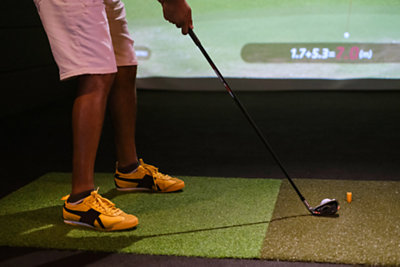Bring the Green to Your Garage: A Guide to Building a Golf Simulator
Here in the Phoenix area, summer temperatures regularly exceed 110 degrees Fahrenheit. For the golfers out there, this can pose a challenge, making it difficult for them to enjoy the game they love.
But there is another way you can play: install an in-garage golf simulator. This is a virtual game of golf that you can play from the comfort of your home.
Wondering how to build a golf simulator in your garage?
We know more than a little bit about the installation of golf simulators and we're going to tell you all about it below. Keep reading for everything you need to know about the ultimate garage golf simulator setup.
The Best Ways to Budget for a Golf Simulator
Now, installing a golf simulator isn't cheap. The installation of a full golf simulator can cost you anywhere from $6,000 to $60,000. This is no small chunk of change, but you have options. We suggest downloading a budgeting app to help you set aside money each month towards your new golf simulation project. Or you can purchase the components of your golf simulator with financing, breaking payments down into monthly installments.
The Best Setup for a Golf Simulator
There are a number of ways you could go about setting up your golf simulator. That said, the best setup, in our estimation, looks a little something like this:
Golf Net
First, let's discuss the golf net. You need something to kill the speed of the balls that you're hitting. If ball speed doesn't die down quickly, you're going to have all sorts of problems.
There are several different options for golf nets. The first is a standard golf net. You can put a TV behind this and create your own DIY golf simulator.
The second option is an impact screen. This is a specially designed projector screen that can stop hit balls moving at high velocities. This type of net is beneficial in that it doesn't impair the user's vision of the screen being projected.
Finally, you could invest in a simulator bay. This is essentially an impact screen with contained sides. It ensures that shanked balls aren't able to go flying.
Simulator bays are the most expensive option. However, they're also ideal for this sort of setup. You can easily make do with the other two types of nets, though your simulator will be lacking in some ways.
Golf Mat
Your golf net should be positioned up against the garage wall, providing you with plenty of space to take your full backswing. Just in front of your golf net, you should place a golf mat. This should extend out far enough so that you can comfortably assume your stance, all while providing some distance between the ball and the net.
Golf mats come in all shapes and sizes. If you want the most comfortable setup possible, splurge and choose one with a tremendous coverage area. If you're buying on a budget, you can get by with a small hitting strip.
Regardless, you can find these all over the internet. They're available between $50 and $250.
Golf Simulation Software
Key to the whole endeavor is golf simulation software. This is software that simulates a realistic game of golf. It not only displays high-quality graphics of a golf course but also interacts with the way you've struck the ball.
There are quite a few golf simulator software options out there, each of which provides something different in terms of functionality and gameplay. Some of the top options now include SkyTrak+, FlightScope Mevo+, and Foresight GC3.
We advise reading reviews on each and finding the best one that fits your budget. Odds are, the newer the simulator, the better it will perform.
Launch Monitor
For a golf simulator to work, a launch monitor is required. This is the instrument that gauges your swing and ball striking to determine how the digital ball will fly in the game.
In many cases, launch monitors are included with the golf simulator software. If your software doesn't include a launch monitor, it's important to take great care to ensure that your chosen launch monitor is compatible with your chosen software. Not all launch monitors work with all simulation software.
Projector
Of course, you'll also need a projector. A projector is needed to display the golf simulation software on a large scale. After all, you can't just look at it on a computer screen; it's quite simply not big enough for these purposes.
You can find projectors at a range of prices. Cheap projectors come in at around $200. The more expensive and higher quality options come in at well over $1,000.
For the purposes of a golf simulator, you don't need anything of extraordinary quality. You just need to be able to see the layout of the course on the screen.
Screen
Finally, you need a screen of some kind. There are a few different options to go with here.
As noted above, you could invest in an impact screen or simulator bay. These are essentially combinations of screens and nets. They not only display what's projected but also slow down golf balls moving at high speeds.
If you don't have the dough for these, you could opt for a simple, white projector screen. In fact, if you wish, you could even project the image of the simulator against a white wall.
If you can't manage any of these, or if you can't afford a projector, you could simply put a large TV behind your golf net. A TV can take the place of a projector, when necessary, though it's not going to feel as immersive or interactive.
How Much Size and Space Is Needed for a Golf Simulator?
The great thing about a golf simulator is that it can be built into a relatively small area. That said, not all garages are big enough to house such an entity.
For modern golf simulators, the recommended length minimum is 12 feet. This should be big enough to contain the simulator itself, the distance between the simulator and the ball, and the length of your backswing, with just a little clearance left over.
Of course, there are width considerations to make as well. Not only do you need enough width to accommodate your golf stance and backswing, but you also need enough width to account for shanked shots (anything could happen, after all).
Most golfers will need 10 feet of width minimum. That said, if you want to be able to aim straight into the center of the projector screen, you'll likely need 15 feet of width minimum.
Then there's height. This can get a little dicey. Obviously, you need enough height to accommodate the height of your backswing.
However, the amount of clearance you'll need to feel comfortable varies from golfer to golfer. You could feel comfortable with as little as 10 feet of height, or you could feel uncomfortable until you reach, say, 12 or 13 feet of height.
You'll need a minimum of 10 feet of height. To get a better feel for what makes you comfortable, go out to your garage and take some test swings. If you're not able to swing comfortably, you'll need to increase the height of your garage's ceiling.
The Importance of Air Conditioning
Living in Arizona, you know just how oppressively hot it can get outside. While the inside of your garage may block out some of the heat, it's still going to feel massively uncomfortable. This is doubly true if you're swinging a golf club over and over again.
You may need to equip your garage with an air conditioner. Air conditioning is the only way to ensure that your garage remains comfortable while you're using your golf simulator. When an AC is properly set up, you can choose your temperature and personalize your indoor golf experience.
Air conditioners don't take up much room. Yes, you'll need to have ducts run into your garage. However, those are separate from the ground level of the garage and won't truly take up any space.
There's also another benefit to installing an air conditioner: improved air quality. Your air conditioner will cycle out airborne contaminants, keeping your garage's air from feeling heavy or dense. It will also stave off potential allergy symptoms, including excess coughing, excess sneezing, burning eyes, itching skin, and more.
If you're interested in installing AC in your garage to enhance the quality of your golf simulator, give us a call. We here at Parker & Sons can make it a reality for you.
And That's How to Build a Golf Simulator in Your Garage
And there it is: how to build a golf simulator in your garage. As you can see, it's easier than it seems. With just a little work, any homeowner could make this a reality.
Looking to install air conditioning in your garage? If you need AC installation in Phoenix, AZ, Parker & Sons are the ones to see. We've installed air conditioning in countless Phoenix area garages, turning it into extra usable space for your home!
Contact us today for a free estimate!
Related Reading
Subscribe to our e-Newsletter
Stay up-to-date on current news, promotions, and industry tips.

